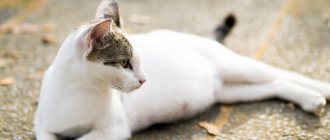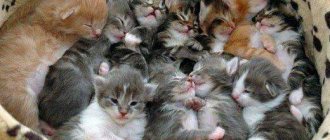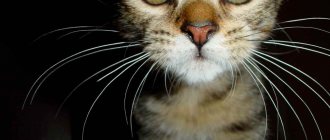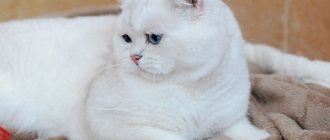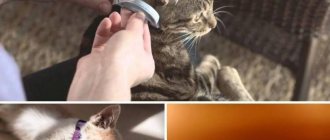What will you learn from the article?
- When do cats go into heat?
- How long does a cat's heat last?
- As often happens
- Signs and symptoms
- How do cats go into heat?
- How to help a cat in heat
- Drugs for estrus Drops, tablets and suspensions for festivities
- Why should you get sterilized?
Estrus in cats is a period of sexual arousal. Like other mammals, these periods occur when they become sexually mature and ready to reproduce.
In this article you will learn everything about this condition and understand the best way to deal with your animal.
Puberty and the cat cycle by stages
Puberty occurs the day cats go into their first heat. Most often this occurs between 7 and 12 months of age. The following factors influence the time of growing up:
- Breed
. In addition to the onset of sexual maturity, breed affiliation determines the characteristics of the course of estrus.
- Cohabitation with animals of the opposite sex
. Kittens from the same litter living together mature at 4-5 months.
- Genetics
. The approximate age of maturity can be determined by the mother of the kittens.
It is impossible to calculate the exact day, since all animals are unique. The only cause for concern is a serious deviation from the average guidelines.
The cat's reproductive cycle consists of 4 stages:
- Proestrus
. The darling is not yet ready to mate, so she drives the cats away. She becomes more affectionate only towards her owner. The duration of this stage is 1-4 days.
- Estrus
. Noticeable discharge appears. Due to raging hormones, the pet screams at night, preventing its owners from sleeping. After stroking, she raises the back of her body, taking a characteristic mating position. This period lasts 5-7 days and is suitable for procreation.
- Metestrus
. After mating, pregnancy occurs at this stage, and sometimes, in its absence, pseudopregnancy. The aggressive attitude towards the opposite sex returns. The duration of the stage is 2-12 days.
- Anestrus
. By the final phase, the animal’s condition stabilizes. A cat's new heat occurs after 3 weeks or several months.
A peculiarity of cat physiology is the absence of ovulation when refusing mating. Without vaginal stimulation, the egg remains in its place.
What is a heat cycle?
The heat cycle is a more accurate way to describe a cat's reproductive cycle. This usually starts when she reaches six months of age, but depending on the breed it can be anywhere from four months to a year. During this time, the cat will be able to mate, ovulate and give birth to kittens.
She can be bred at any time in this cycle and may even have a litter of multiple males. Estrus can last from one day to a week. It will be another week or two before she goes into heat again. Environmental factors can influence the length of the breeding cycle.
Cats are ovulatory inducible, meaning that she will continually come and go until she is bred. If you don't want kittens, it's best to have her spayed.
Cat's first heat
The first estrus is exciting for both the owner and the animal. The time of its onset and characteristic symptoms largely depend on the breed.
At what age does it start
In addition to the breed, genetics and the fact of cohabitation with a cat, sexual maturity depends on several other factors. These include:
- Location
. Pets take longer to mature than street animals. Lighting at home is also important, stimulating the activity of sex hormones.
- Time of birth
. Pets born in the fall are inferior in speed to those born in the spring.
- Animal size
. Those with small dimensions are ahead of larger representatives.
- Body mass
. Too much or too little weight prevents timely maturation.
- Wool length
. The shorter the coat, the earlier sexual maturity will occur. Orientals and Abyssinians mature at 5 months, British and Scottish females at 8-12 months, and fluffy Siberians, Ragdolls and Maine Coons at 9-15 months.
Please note that puberty is not the same as physiological maturity. It is strictly forbidden to breed your pet for the first heat.
Characteristic manifestations
Before menstruation is about to begin, the pet begins to roll on the floor and rub against the owner’s legs, trying to attract his attention. After stroking the back, she lifts the back of her body, moves her tail and fussily moves her paws.
To attract a cat, the kitty meows long and loudly or purrs intensely. She can start her songs at any time of the day, which really bothers the owners who are trying to get some sleep before work. Trying to find a mating partner, the pet may attempt to escape. During this period, you will have to keep the doors and windows closed.
In addition to behavioral changes, consider physiological characteristics. These include:
- decreased appetite;
- increase in vaginal size;
- prolonged licking of the perineum due to increased urination;
- the appearance of transparent discharge.
The first “critical days” are almost invisible. This is due to the fact that physiologically the animal continues to develop. More distinct signs appear the second time.
Features of the first estrus
Maine Coon sexual heat is accompanied by strong thirst and indifference to food. Their growth temporarily stops, so don't be alarmed by the lack of change.
British women often change their mood, alternating affection with aggression. But with the sphinxes everything is stable. Owners will have to put up with their loud screams, irritability and completely uncontrollable behavior.
Siamese are the quietest. Thanks to their calmness, “critical days” can be recognized only by physiological signs. Scottish women are no less calm - they do not shout loudly and do not stand in a characteristic pose. Only excessive affection gives them away.
These signs may not appear - after all, each cat’s body and temperament are individual. You may “get” a loud Siamese or a very quiet and affectionate sphinx lady.
How to relieve a cat's condition
To make it easier for you and your cat to survive the difficult period of her estrus, follow these helpful tips:
- Distract with games - it is useful to stock up on new toys and invent new entertainment, preferably outdoor games. The more tired the cat is from playing during the day, the more peacefully the cat will sleep at night;
- Pay more attention - calm, caress the pet, pick it up more often so that the cat feels your support;
- Feed on a different schedule - a cat in heat has a decreased appetite, so reduce portions, but offer food more often.
It makes no sense to scold a cat for its physiological characteristics. The animal follows its nature and cannot voluntarily stop calling the cat and worrying. The best option is to be patient and get through this period.
Advice about taking your cat to the shower or locking it in the dark will not help ease or speed up the course of estrus. Sudden swimming will only cause stress, and staying in the dark will make you nervous and adversely affect the nervous system.
A radical option to stop estrus for a while is to breed a cat with a cat. But be prepared for the possible appearance of offspring.
Periodicity of estrus
There is no clear answer to the question of how often cats go into heat. The frequency is individual and depends on the following factors:
- Breed
. Persians, Orientals and Siamese women flow more often than British and Scottish women. For the latter, the break can be up to 5-8 months.
- Presence of pregnancy
. Cat menstruation returns to its usual schedule only 1.5-3 months after birth. An earlier return is possible in case of death of the litter or separation from the kittens immediately after birth.
- Age
. The younger the animal, the more often it is ready to mate.
- Season
. The breaks shorten from early spring to mid-autumn and increase with the arrival of winter. This is due to the fact that in the warm season it is easier to carry and give birth to healthy offspring. The exception is pets who do not leave the apartment for a year. Thanks to comfortable living conditions, their schedule does not change.
- Breeding frequency
. Rare meetings with representatives of the opposite sex reduce the period of calm to 2 weeks. If mating is too frequent, the opposite is true - constant mating reduces the number of menstruation to 2 times a year.
On average, estrus occurs 4 times a year, that is, once a quarter. But for some, this process can occur every 3 weeks or once every six months. In the absence of pathologies of the reproductive system, this is completely normal.
Frequency of estrus
If there has been mating, fertilization and pregnancy occur, this stops the estrus. On average, the pet bears kittens for 2-2.5 months, and she does not give birth.
After childbirth, physiological processes are restored after about 3.5 months. The onset of estrus is observed earlier if the litter is stillborn.
If pregnancy does not occur, estrus continues as usual. The intervals between them range from 1 to 3 weeks.
It depends on individual characteristics:
- animal physiology;
- season;
- living conditions;
- breed.
British and Scottish Fold cats go into heat less frequently than Siamese and Persian cats. In the autumn-spring period, sexual activity increases significantly.
Duration of “critical days”
The average duration of “critical days” is 5-7 days, but sometimes it can last up to 14-20 days. Due to the variety of factors influencing this process, it is almost impossible to determine how long a cat's first heat will last. Most often it goes faster, but it is better to start from average indicators.
If sexual activity exceeds 3 weeks or lasts less than 5 days, take your pet to a veterinary clinic for diagnosis. In the first case, there is a possibility of developing tumors or inflammation in the ovaries, and in the second - pathologies of the thyroid gland or ovarian hypoplasia.
Deviations from the norm
For most pets, estrus is calm and painless. However, some cats are susceptible to hormonal imbalances or have a predisposition to abnormalities.
Prolonged heat
This refers to estrus that has lasted for more than 14 days. The phases of the physiological process are extended, going beyond a certain norm. At this time, mucous discharge does not stop, but at the same time the cat is aggressive and does not allow the cat to approach, so fertilization does not occur.
Anaphrodisia
This is the complete absence of any signs of estrus in an adult cat. A delay in normal puberty is accompanied by a similar deviation. In any case, the animal must be shown to a competent veterinarian, who will prescribe treatment.
False pregnancy
If fertilization does not occur, but all the symptoms of pregnancy are present, a false pregnancy appears. The pathological condition is determined by the doctor.
Some breeds, such as Sphynxes, have a predisposition to such manifestations. In most cases, it is still a psychological problem that develops due to stress.
The animal's behavior also changes. The cat looks for a secluded place, often carries soft objects in its teeth, considering them its children, while its stomach and mammary glands swell, its appetite and thirst increase. The pathological condition is dangerous due to the development of a complication – purulent mastitis.
Empty heat
This is a situation when the estrus has ended, but the pet has not become pregnant. This condition is dangerous due to the development of ovarian cysts, inflammatory processes in the reproductive system and even cancerous tumors.
If the owner does not plan to go through the procedure of mating animals, it is better to immediately sterilize the pet.
Bloody issues
According to the norms, a cat should not have bloody inclusions in its discharge. If such a phenomenon was noticed by the owner, it is better to immediately show the animal to an experienced veterinarian to determine the problem.
Signs of estrus
To attract males, females use 2 tools: voice and smells. All sounds made become rougher and louder. Frequent but light urination occurs not only in the litter box - the pet leaves odorous marks on vertical and horizontal surfaces. Raising her tail and turning her back towards the target, she secretes a few drops of urine.
Another way to place marks is by rubbing them on objects. The glands on the cheeks of furry pets secrete a special secretion, allowing them to leave an individual scent.
The signs of the first menstruation are identical to subsequent ones. They are distinguished only by their weak expression in young animals.
Remember that discharge during “critical days” should be transparent. The appearance of blood or pink clots is a dangerous symptom that requires diagnosis.
How will this cycle affect my cat?
A cat can act a little strange when she is in heat (again, this is a little different than her period). She can sing more than usual. She may rub herself against people and objects more than usual. She may start crawling with her butt on the ground or acting restless in general. She is often more demanding, demands more attention and insists on going outside.
© shutterstock
You may notice that she squats with her butt up quite often, usually while screaming. This noise may seem unpleasant to you, but it sounds like “Come and get me, big boy!” to the cat If she doesn't get what she expects, the cat may become upset, irritable and agitated.
The most unpleasant change in a cat's behavior during heat is her constant urination. Even worse, she won't want to do it in the litter box. She will have the urge to spray her scent onto every vertical surface. If she puts her butt on a vertical surface and raises her tail, something unpleasant will happen!
How to calm a cat
Having figured out how to understand that a cat has gone into heat, it remains to figure out what to do if the owner does not want to endure constant nightly arias. There are only two cardinal solutions: pregnancy and sterilization. The operation not only suppresses sexual desire, but also prevents the development of cancer.
When choosing regular matings, unwanted behavior goes away only temporarily, so to calm your pet you will have to resort to medications, changes in activity and diet.
Change of activity and food
Aggression and increased activity can be directed towards toys. Long games use up increased energy reserves and normalize night sleep. Try to distract your pet during the daytime sleep to exhaust him by nightfall. Also, do not forget about increased attention. Talk and pet your pet more often. Your love will help reduce your stress levels.
Another trick to ensure long sleep is abundant feeding later in the day. Temporarily limit constant access to the feeder and give out food strictly on a schedule. After a night of feasting, all energy will be spent on digestion, and not on concerts.
Remember that with an increase in the evening portion, the volume of the daily ration remains unchanged. Otherwise, there is a risk of obesity. Meals should be small and easily digestible so as not to overload the gastrointestinal tract.
Sedatives
Veterinarians recommend sedatives made from herbal preparations (Cat Bayun, Stop-Stress). They are not addictive and do not have severe side effects. Their only contraindication is the presence of an allergy to one of the components.
Hormonal drugs
Taking hormonal medications (Stop-Intim, Sex-Barrier) is possible only as prescribed and under the supervision of a veterinarian. These medications directly affect hormonal levels, which can trigger the development of pathologies of the ovaries and uterus, including cancer.
With the constant use of hormones, 70% of animals endure forced sterilization for medical reasons. It is much safer to deprive your pet of reproductive function soon after puberty.
What not to do
Please note that traditional methods of calming are not only cruel and senseless, but also dangerous. Avoid raising your voice or using physical punishment. Compliance with this rule is the key to a strong and respectful relationship with any pet. Don’t try to judge your pet for nighttime insomnia and leaving marks - all this happens not out of malice, but under the influence of hormones.
Do not cool your genitals with ice water. This will not only frighten the animal, but can also cause inflammation.
Don't try to lock your pet in a dark room. The sun's rays do stimulate hormones, but staying in a confined space for a long time will only lead to mental disorders.
What should I do if my cat is in heat?
There are only two real options here. You can just let her mate with the cat. (Not recommended as this will give you a litter of kittens in need of rehoming at best, or a sick, injured or dead cat at worst.)
Or you can further ensure that she does not approach male cats. Her howls and scents are sure to attract the attention of the local cats, so you may have trouble with a few gentleman callers who want to know if the cat can come out and play.
It's best to wait. The cat does not need any changes in its diet, but it could use some toys to relieve stress. Not those kinds of toys! Buy her something cheap that she can tear into pieces while working through her frustrations.
Something infused with catnip can help her forget about her problems. Of course, the simplest solution is to not deal with the cat at all when she's in heat. And this also lets us down….
How and when to mate
The first mating is carried out on the third menstruation, when the pet has reached physiological maturity. This reduces the risk of miscarriages, infertility and other complications.
Before meeting her partner, the “bride” is vaccinated and dewormed. Her nails are trimmed and a set of personal items is collected that she will need while away from home. Mating is carried out on the male's territory to reduce his excitement.
The animals are left alone for several days to repeat cages many times. This consolidates the result, increasing the chances of successful fertilization. Help from the owners is required only in cases of aggressive behavior, discrepancies in the size of the partners, and the cat falling on its side.
Empty estrus in a cat and constant use of hormonal drugs have a negative impact on health. If there is no labor, sign up for sterilization.
How to help a cat during heat?
Under no circumstances should you leave your cat with a neutered male. Such a meeting will only aggravate the process. Since the cat cannot bear offspring, the cat will mate without fertilization. Such mating leads to ovarian dysfunction.
You should not give your cat hormonal medications without a veterinarian's prescription. Such interference can lead to serious consequences. It is better to contact your veterinarian, he will select a special drug for your cat.
Remember, the systematic use of hormonal drugs leads to a malfunction of the cat’s body. Inflammations may appear, which are very difficult to treat. Usually such inflammations are removed surgically. And treatment after surgery is very difficult and lengthy. If you do not want such problems and are not going to breed kittens, then you should sterilize your cat.
Can a spayed cat go into heat?
It all depends on the type of operation chosen. Most often, females are not sterilized, but castrated. These operations are often confused, suggesting that the latter is performed only on males. In fact, sterilization is a tubal ligation that prevents fertilization. A neutered female cat will not be able to give birth to kittens, but will still want to mate due to the influence of hormones.
Changes in hormonal levels can only be achieved by castration. The operation is divided into 2 types:
- oophorectomy, which involves removing the ovaries and preserving the uterus;
- ovariohysterectomy, which involves the removal of all reproductive organs.
The first method reduces the risk of developing polycystic disease and breast tumors, but does not protect against uterine cancer. For this reason, the second method is more reliable.
For simplicity, veterinarians may use the same terms as owners. Before the operation, be sure to discuss the purpose and method of surgery to avoid misunderstandings.
Sterilization
It is recommended that the queen be spayed to prevent her from going into heat or conceiving kittens. This procedure is also known as ovariohysterectomy, surgical sterilization, or simply "fixing." It's never too late to sterilize your cat. It is recommended to carry out the procedure in the sixth month of life or earlier.
There are many myths about sterilization that need to be dispelled. It is not necessary or even recommended that your cat have bedding before being spayed. It won't make her fat or stop her from growing.
The procedure, which takes a couple of hours, will mean that the cat will no longer experience the hormonal flow associated with the heat cycle and will not be able to have kittens. This can be a major stress reliever for both you and your cat.
Posted by: Mary Nielsen Huge animal lover, born and raised around dogs, cats, chickens... Self-taught pet care nerd. Currently parent to three foster cats and one small mongrel. Animal adoption advocate. Loves good books (about animals) and plays the piano.
Diagnosis
If, when examining a sick cat, the veterinarian finds blood, pus, urine or feces in abnormal quantities, the veterinarian will need to review the cat's medical history and conduct a risk assessment.
A thorough medical examination of the cat is required to make an accurate diagnosis.
Call a veterinarian Moscow
+7(495)162-70-70
- Blood tests
- General urine analysis
- Vaginoscopy
- Vaginal cytology
- Biopsy
- X-ray
- Ultrasound
Signs of heat
It is important to recognize the first signs of heat in a cat initially. This will allow the owner to prepare in advance and take appropriate measures. For example, to prevent a pet from possibly falling out of a window or balcony during heat.
The sexual drive in animals is so strong that they lose their instinct of self-preservation. Quite often, cats run away from home during heat and may not return, for example, due to being hit by a car. This is especially true for owners whose cats have led an absolutely domestic lifestyle since birth.
Symptoms of a cat's first heat are characterized by the following changes in behavior:
- the pet begins to fawn intensively;
- possible manifestation of unmotivated aggression;
- the cat makes various sounds while “searching” for a potential groom;
- requires increased attention to oneself;
- may bite if the owner stops petting the cat.
It is worth noting that the above-described signs of estrus in a cat can be diagnosed 14-18 days before the start of sexual heat. Estrus occurs with increased severity. The pet becomes affectionate, tries to stick out the back of its body, and rubs against the surface. Can close eyes and make uterine sounds.
The absence of a male during the acute phase of estrus leads to the fact that the cat begins to growl and scream inwardly, demanding procreation. This call can be heard by cats from the surrounding area, also announcing their presence with characteristic guttural howls and sounds. Males often start fights in the fight for a potential female, which also alerts the surrounding area.
An owner who does not want to receive offspring from his pet must carefully monitor her. Cats are unusually cunning, so during the period of sexual heat they are able to jump out into the street with great speed through even a slightly open door.
How is a cat sterilized?
Usually the operation is performed after the first heat, before the formation of the reproductive system.
To undergo sterilization, you must make an appointment for surgery. Before this, the veterinarian will take all the necessary tests from you. Check the heart for pathologies. Once the doctor decides that the cat is healthy, he will schedule a day and time for surgery.
All necessary examinations are carried out to determine the dose and type of anesthesia that is suitable for a particular cat.
Veterinarians perform the operation in two ways:
Abdominal incision . It is done for adult cats and for complications when maximum access to organs is necessary.
Laparoscopic method . The operation is performed through a small hole. This intervention is less traumatic. The pet recovers faster after surgery.
Carry out sterilization only in trusted clinics. Experienced veterinarians and new equipment will help avoid critical situations during surgery. Also, large veterinary clinics do not give the pet back to the owner after surgery, but monitor his condition until he wakes up and all vital signs are normal.

